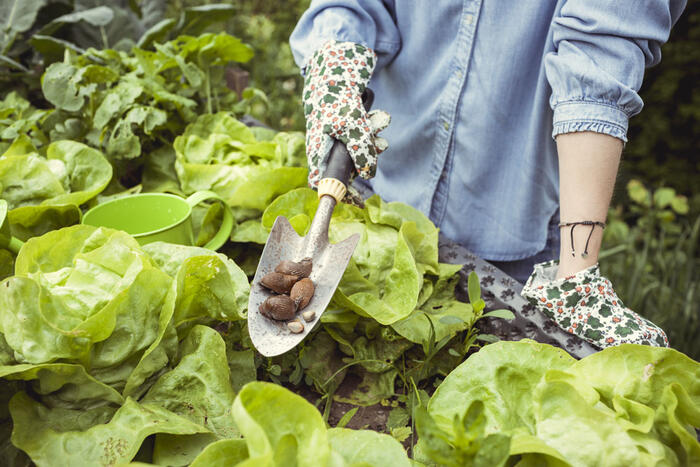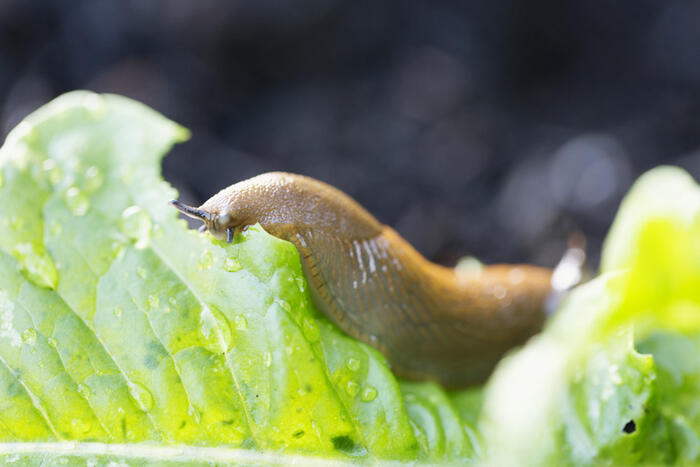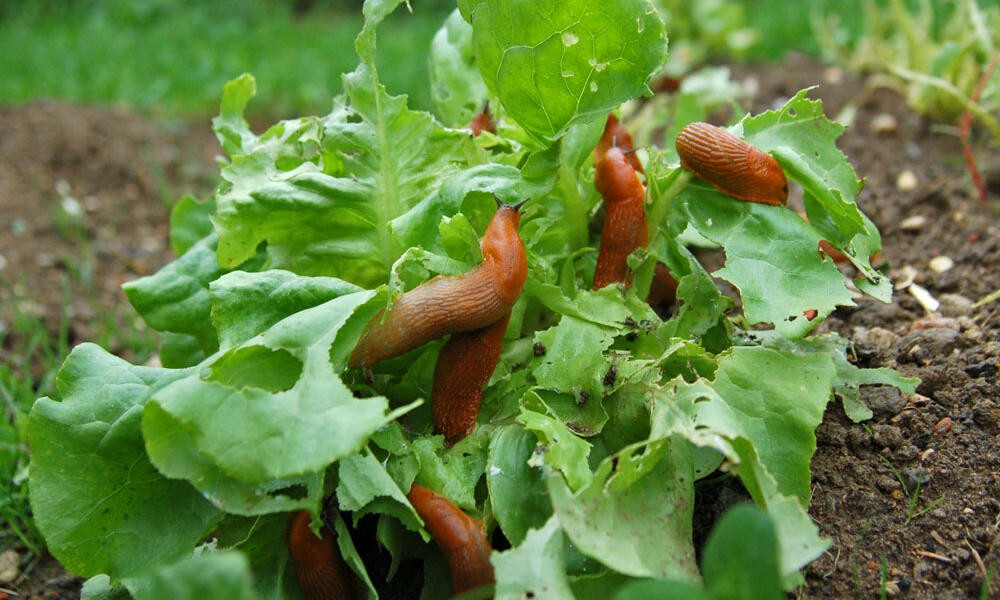Slugs and snails are uninvited guests in many gardens, as they can eat many vegetables and ornamental plants down to their bare stems overnight. We show you how to combat the animals in an environmentally friendly way.
The most important thing in a nutshell:
- Numerous home remedies such as coffee or sawdust help against snails
- The most effective way to collect slugs is to do it consistently every day
- In a natural garden you will have fewer snail problems
Contents
- 1 Which snails are a problem in the garden?
- 2 Prevent a snail infestation
- 3 Pick off snails
- 4 Fighting slugs with predators
- 5 Plants against slugs
- 6 Fighting snails with coffee
- 7 Barriers against slugs
- 8 Beer trap with pitfalls
- 9 Snail fence for the flower bed
- 10 Snail paste for pots and walls
- 11 Fighting slugs with slug pellets
- 12 Do not use salt against slugs
- 13 Author
Which snails are a problem in the garden?
When it’s damp and overcast, slugs dare to come out of hiding and spread throughout the garden. Yet most snails are not harmful to plants. Many species of snails – especially shell snails such as ribbon snails or Roman snails – usually eat dead plant parts or pests. On the other hand, slugs such as the Spanish slug, the garden slug and the field slug cause problems. The latter climbs onto the plants and prefers to eat the young, soft plant parts. Their young remain in the soil and feed on the roots. Also living in the soil is the garden path snail. On their menu are mainly roots. You can recognize them by their gray to black coloring and their yellowish to orange sole.
To combat snails, you have several options. We present you methods that help sustainably against the mollusks.
Prevent a snail infestation
It is best to fight snails before they can become a problem. To do this, you need to know that the animals build so-called snail clutches in the winter, in which they lay hundreds of eggs. In late fall or early spring, loosen your vegetable beds deeply or hoe them thoroughly. This will bring the clutches to the surface, where they will be eaten by a wide variety of animals or destroyed by the weather. Also, don’t water your beds in the evening, or you’ll provide ideal living conditions for nocturnal slugs. Instead, water in the early morning. Targeted watering of each plant also helps prevent slugs because this watering method requires the mollusks to travel longer distances on dry ground. Also, don’t mulch your beds too thickly because the mulch layer is an ideal shelter for the pests.
Pick off snails
Slugs are nocturnal animals, so they tend to show up in the evening and morning. Take advantage of this and collect snails from plants by hand. They like to hide under wooden boards during the day – specifically create such hiding places in the vicinity of endangered plants and check them daily. Place the collected animals at least 20 meters away from your garden – researchers have found that snails then no longer find their way back to the place of origin.

Fighting slugs with predators
An effective method against slugs is to encourage their natural enemies. Many animals feed on slugs or their eggs. To do this, create a natural garden where beneficial insects feel at home. The most common predators are birds. They eat mainly smaller slugs and their eggs. Attract blackbirds, magpies, titmice or starlings to your garden with appropriate birdhouses.
If you have a large garden with an area of over 400 square meters, it may be worthwhile to purchase Indian Runner Ducks. They will independently search for slugs and prevent them from spreading. Keep in mind, however, that the ducks require some maintenance and may cause trouble with neighbors. You will also need to feed them, as snails do not provide the complete food requirements.
There are also species of snails whose diet includes slugs and their eggs. These include, for example, the Roman snail and the tiger snail. Also helpful are some insects such as fireflies, centipedes and ground beetles and their larvae. They eat slug eggs and young slugs. Other beneficial insects in the fight against slugs are slow worms, toads and shrews. Hedgehogs are also basically among them, but they eat snails only when they find few insects or worms as food. Snails also transmit parasites that can harm hedgehogs.
For some time now, professional vegetable gardeners have also been using nematodes against snails. You apply the nematodes with the irrigation water and they then penetrate the slugs. The disadvantage is that they attack only the Genetted Slug, which is rather rare in gardens. They are ineffective against the main enemy – the Spanish slug.
Plants against slugs
Another way to control slugs is to plant certain plants. Savory and chamomile are said to be deterrents to slugs. Plant them around a bed to keep them away. You can also spray plant extracts to combat the pests. Harmless to plants but effective against slugs are extracts of bracken, liverwort or compost. For example, spray fern broth, lavender cold water extract or wormwood liquid manure regularly over your vegetable patch to control the mollusks. Strong-smelling plants also keep slugs away. So combine your vegetable plants with nasturtiums, garlic, lavender, rosemary, thyme, ornamental garlic or onions.
Another tactic is to target slugs with their favorite plants to lure them away from other vulnerable plants. For example, plant basil, marigolds, sunflowers or unneeded lettuce as decoy plants along garden or bed borders. You can leave these plants to the animals and simply pick off the slugs on a regular basis.

Fighting snails with coffee
Coffee not only wakes you up and drives away unpleasant odors from refrigerators, but it also helps fight slugs. Spread old coffee grounds around your plants or spray cold coffee. Even in low concentrations, the animals will stop eating. Highly concentrated coffee is said to act like a neurotoxin on slugs, killing the pests. However, reports on this method are contradictory – in some cases, the desired effect was not achieved.
Barriers against slugs
Natural barriers are a sustainable way to control slugs. For example, spread quicklime, dry sawdust or stone dust around your bed. These substances remove moisture from slugs and make it difficult for them to get into the vegetable bed. Pick up any pests that have made it into the bed and renew the protective barrier after every rain shower. The protective ring should be between 30 centimeters (for quicklime) and one meter (for sawdust) wide. When applying lime, keep in mind that it raises the pH of the soil.
A layer of wood ash should also keep slugs away from the bed, as the ash is too dry for the animals. A practical side effect is that wood ash also serves as a potassium fertilizer. Also good barriers you build from dry bark mulch, sand or pine cones.
Beer trap with pitfalls
So-called beer traps are popular in the fight against snails. A cup is sunk into the ground and filled with beer. The scent of the drink attracts the mollusks, they fall into the cup and drown. While this method is effective, it has a major drawback: instead of getting rid of the slugs, you often attract your neighbors’ slugs to your garden with a beer trap. In addition, the beer trap does not guarantee that all the slugs will fall into it.
Snail fence for the flower bed
Slugs can also be controlled with a slug fence that you place around your vegetable bed. The boundary is available in a wide variety of materials such as sheet steel, concrete or plastic. It is best to place a slug fence only around individual beds that are at high risk from slugs, as the fences are comparatively expensive. A curved top edge on the snail fence is an insurmountable obstacle for the animals. To prevent the snails from climbing over after an effort, the edges are often very thin and or additionally studded with serrations or teeth.
Snail fences are only effective if you build them correctly. There should be no gaps at the corners through which the pests can squeeze through. Also, make sure there are no plants overhanging the fences that slugs could use as a bridge, and leave the slug fence at least ten inches into the soil. Care should also be taken with fine wire mesh fences. Small slugs can squeeze through the mesh and wreak havoc in the bed.
Another option is an electric fence that you power with batteries or solar panels. The fence emits weak electrical pulses that do not harm humans or animals. Slugs, however, are deterred by the pulses. Disadvantage: The maintenance effort is quite high. Short circuits occur more often because the wires are in contact with soil and moisture.
However, you don’t have to fence off entire beds to protect individual plants from slugs. Alternatively, there are so-called slug collars that you can put over vegetable plants. Wires and chains made of copper should also help against the animals, as the material deters them. Even in small quantities, dissolved copper is toxic to the mollusks.
Snail paste for pots and walls
If you want to protect potted plants from snails, snail paste is a good choice. This is transparent and contains scents that deter the mollusks. The advantage over protective barriers made of quicklime, sawdust or stone dust is that the paste can withstand a rain shower and only needs to be replaced after a few weeks. Slug paste is harmless to animals because it does not contain toxins.
Fighting slugs with slug pellets
If you have used all natural means against slugs and still suffer from a slug infestation, the only thing that usually helps is to reach for slug pellets. Apply it in March or April to combat the mollusks. The early timing prevents more generations of slugs from forming. Plus, the bait is best received this early in the year because slugs can’t find as much plant food yet. Until 2014, slug pellets containing the neurotoxin methiocarb were available – it was very effective, but other animals could also be poisoned by it. That is why it has now been banned.
There are now only two active ingredients: metaldehyde and ferric phosphate. The latter is much more environmentally friendly, since it is a natural mineral that also occurs in nature. In addition, it may also be used in organic farming. Important when using slug pellets: check the bait daily and sprinkle in time to achieve a good effect.
Do not use salt against slugs
In the past, amateur gardeners often sprinkled salt on slugs in the garden. It causes an agonizing death as it deprives the animals of moisture. Moreover, in higher concentrations, it also harms the soil. If you want to kill the captured slugs, you should cut them with secateurs or a sharp knife – this method, despite its supposed brutality, is the most animal-friendly.


